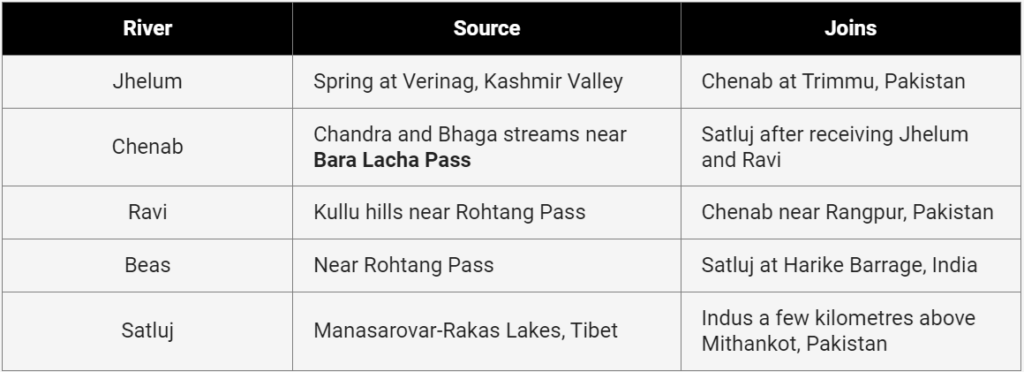8 July 2024 : Indian Express Editorial Analysis
1. A BEND IN THE RIVER
(Source: Indian Express; Section: The Editorial Page; Page: 08)
| Topic: GS2– International Relations – Agreements involving India or affecting India’s interests. |
| Context: |
|
What is Indus Waters Treaty?
- India and Pakistan signed the IWT in September, 1960 after nine years of negotiations, with the World Bank being a signatory to the pact.
- The treaty sets out a mechanism for cooperation and information exchange between the two sides on the use of the water of the Indus River and its five tributaries Sutlej, Beas, Ravi, Jhelum, and Chenab.

Changing Realities and the Need for Amendments
- Emerging realities, particularly climate change, necessitate revisiting the treaty.
- In 2015, NASA ranked the Indus basin as the world’s second most over-stressed aquifer. Approximately 31% of the net basin flow originates from climate-impacted glaciers and snowmelts, leading to more volatile and seasonal mean annual flows.
- Unpredictable monsoons further increase flow variability. Given the crucial role of the Indus in the agriculture-dominated economies of India and Pakistan, these changes pose significant challenges.
- Over 90% of Pakistan’s agricultural output depends on the Indus, and deteriorating water quality threatens food and nutritional security, human health, and biodiversity.
Contentions and Trust Deficits:
- Disagreements within the IWT framework primarily revolve around infrastructure development impacts on downstream flows.
- Pakistan, as a lower riparian state, expresses concerns over projects like India’s Shahpurkandi barrage, accusing India of “water terrorism.”
- However, the Ravi’s water flow into Pakistan is minimal, and the dam aims to streamline the river’s flow, supporting power supply and agricultural growth within legal IWT limits.
- The massive trust deficit between the two neighbors exacerbates these issues.
Ecological Perspectives and Environmental Flows
- There is a need to integrate an ecological perspective into the treaty’s governance framework, including institutionalizing Environmental Flows (EFs).
- According to the Brisbane Declaration, EFs are essential to sustain aquatic ecosystems, supporting human cultures, economies, sustainable livelihoods, and well-being.
- Harmonizing EFs with principles from the 1997 UN Watercourses Convention, such as equitable and reasonable use and the duty to prevent significant transboundary harm, is crucial. International customary law, including the 2004 Berlin Rules on Water Resources, supports these concepts.
- The Permanent Court of Arbitration’s 2013 verdict on India’s Kishanganga project underscored the obligation to release EFs downstream, setting a precedent for maintaining EFs in transboundary river basins.
Addressing Climate Change and Population Pressures
- A nuanced understanding of climate-change impacts and population pressures on river hydrology is essential.
- Developing a mechanism for real-time data sharing between the two riparians and evaluating water quality and changing flow magnitudes in numeric terms can help.
- A legally binding, World Bank-supervised data-sharing framework within the IWT would ensure accountability and enhance policy understanding of water-quality challenges.
Re-establishing the Treaty in the Face of Climate Change
- Recognizing climate change as a common vulnerability and shifting focus to holistic basin management can reinforce the treaty’s significance in Indo-Pak relations.
- Such an approach would address emerging challenges effectively and ensure sustainable water resource management for both countries.
| Indus River and its Tributaries |
|
Source:
Course and Major Tributaries:
|

|
PYQ: With reference to the Indus river system, of the following four rivers, three of them pour into one of them which joins the Indus directly. Among the following, which one is such a river that joins the Indus direct? (2021) (a) Chenab Ans: (d) |
| Practice Question: Discuss the historical significance of the 1960 Indus Waters Treaty (IWT) between India and Pakistan and evaluate the need for its amendments in light of contemporary challenges such as climate change and increasing population pressures. How can the integration of ecological perspectives and real-time data-sharing mechanisms enhance the effectiveness of the treaty? (250 words/15 m) |
2. Hoping for a miracle at COP29
(Source: Indian Express; Section: The Ideas Page; Page: 09)
| Topic: GS3– Environment |
| Context: |
|
What is Conference of the Parties (COP)?
COP is the annual United Nations (UN) climate meeting
- In 1992, at the Rio Earth Summit, 154 countries signed a multilateral treaty called the United Nations Framework Convention on Climate Change (UNFCCC).
- It aimed to stabilise greenhouse gas concentrations at a level that would prevent dangerous anthropogenic (human-induced) interference with the climate system.
- The treaty came into force two years later, and since then, countries which are part of the UNFCCC, meet every year at different venues.
- Today, there are 198 ‘parties’ or signatories of the Convention.
- COP was a result of a strong belief in the power of international agreements to tackle environmental problems
- Policymakers of that era believed in a unified commitment to deal with climate change.
- Their belief was strengthened by the success of:
- the 1987 Montreal Protocol, an international treaty designed to protect the ozone layer, and
- a 1991 bilateral agreement between the US and Canada that helped combat acid rain by limiting the emission of sulphur dioxide (SO2).
- This led to the inception of UNFCCC.
What is the New Collective Quantitative Goal?
- The NCQG is a new annual financial target that developed countries must meet from 2025 onward to provide climate finance to developing countries.
- It will replace the previous commitment of USD 100 billion per year that developed nations had pledged in 2009 but failed to deliver.
- The final NCQG amount is expected to be a central point of negotiation at the COP29 summit in Baku, Azerbaijan, in November 2024.
- The NCQG negotiations aim to set a higher collective amount that wealthy countries will need to mobilise annually for mitigation, adaptation, and other climate action efforts in poorer nations vulnerable to the impacts of climate change.
- Securing an adequate NCQG figure is extremely important for developing countries, as a lack of sufficient climate finance has been a major barrier to implementing effective climate plans and building resilience against global warming’s effects.
Financial Needs and Disparities
- The actual financial requirements for effective climate action are estimated to be in the trillions of dollars annually, not billions.
- The $100 billion figure was established over 15 years ago without thorough assessment, and the current need ranges from $1 trillion to $6 trillion annually.
- China’s significant economic growth and status as the largest polluter have led to calls for it to contribute to the fund.
- When the Kyoto Protocol was finalized in 1997, China’s GDP per capita was 25% of the world average; by 2020, it had reached parity.
Developing vs. Developed Country Debate
- China maintains that it is still a developing country under UNFCCC guidelines and that resource transfers should flow from developed to developing countries as per Article 9 of the Paris Agreement.
- India has not yet been called to contribute but may be asked to in the future. The debate over who should contribute to the fund seems to be a tactic to delay actual resource transfer, adversely affecting the developing world, particularly small island states threatened by rising sea levels.
The Loss and Damage Fund
- While addressing the NCQG, the international community must also focus on the Loss and Damage Fund.
- Despite failing to mobilize the original $100 billion, a new, larger financial commitment is required. Contributions from the developed world alone will not suffice; relatively affluent developing countries must also contribute.
- The fund currently has a committed sum of $800 million, but access criteria are still under debate. Finalizing these details will be a key agenda item at COP29 in Baku.
National Adaptation Plans (NAPs)
- The lack of resource transfer from the developed world is often cited as a barrier to effective climate action.
- However, countries are also expected to prepare National Adaptation Plans (NAPs) to respond to climate impacts.
- To date, only 57 countries have submitted their NAPs, partly due to capacity constraints in poorer nations. India, too, has yet to submit its plan.
Worsening Climate Conditions
- The situation continues to deteriorate. The World Meteorological Organization (WMO) declared 2023 the hottest year on record and predicted an 80% likelihood that global temperatures will exceed 1.5°C in the next five years.
- This temperature rise has already led to numerous climate-related disasters worldwide, including severe cyclones in Bangladesh and intense heatwaves in India.
Geopolitical Complications
- COP29 is taking place amidst significant geopolitical turmoil, including the upcoming US presidential elections, conflicts in Ukraine and Gaza, and trade hostilities with China.
- These issues are likely to overshadow climate negotiations. Historically, COP negotiations have often involved going through the motions with limited outcomes, and it remains to be seen whether COP29 will yield any significant breakthroughs.
| What is Climate Financing? |
|
|
PYQ: With reference to the Agreement at the UNFCCC Meeting in Paris in 2015, which of the following statements is/are correct? (2016) 1) The Agreement was signed by all the member countries of the UN, and it will go into effect in 2017. 2) The Agreement aims to limit the greenhouse gas emissions so that the rise in average global temperature by the end of this century does not exceed 2ºC or even 1.5ºC above pre-industrial levels. 3) Developed countries acknowledged their historical responsibility in global warming and committed to donate $ 1000 billion a year from 2020 to help developing countries to cope with climate change. Select the correct answer using the code given below: (a) 1 and 3 only (b) 2 only (c) 2 and 3 only (d) 1, 2 and 3 Ans: B |
| Practice Question: Discuss the implications of the New Collective Quantified Goal (NCQG) and the Loss and Damage Fund, emphasizing the roles of developed and developing countries in resource transfer. Evaluate the importance of National Adaptation Plans (NAPs) and the impact of geopolitical factors on the effectiveness of international climate negotiations. (250 words/15 m) |


